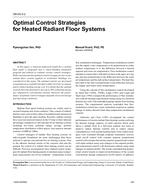Description
In this paper, a transient numerical model for a radiant floor panel is integrated into a whole-building simulation program and utilized to evaluate various control strategies. Both conventional and optimal control strategies for hot-water radiant floor systems applied to residential buildings are considered in this paper. The optimal controls are developed to maintain an acceptable thermal comfort level for occupants and to reduce heating energy cost. It is found that the optimal controls have the potential to save up to 30% of heating energy use compared to conventional controls. However, the performance of optimal control strategies depends on several design and operating conditions.
Units: Dual
Citation: Symposium, ASHRAE Transactions, vol. 111, pt. 1, Orlando 2005
Product Details
- Published:
- 2005
- Number of Pages:
- 12
- File Size:
- 1 file , 5.9 MB
- Product Code(s):
- D-25535




